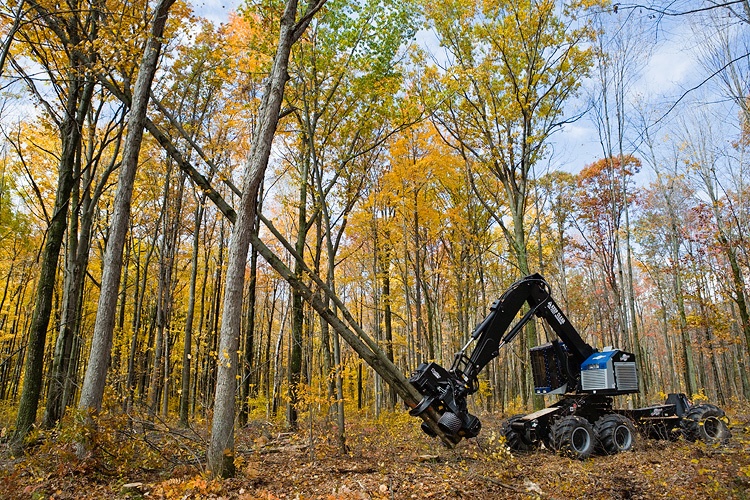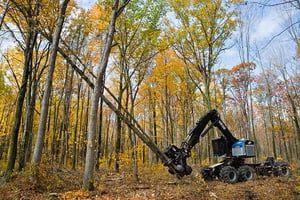
Per a recent article in the Great Lakes Echo, climate change could have profound effects on forests in the Great Lakes region over the coming decades. While the earth’s weather patterns have always been subject to wild swings and extremes from season to season and year to year, most experts generally agree that these changes will intensify and cause a host of challenges as the 21st century progresses.
Even when silvicultural best management practices are in place, a number of natural and weather-related factors can affect forests at any given time. Droughts, fires, pest invasions and major weather events (such as hurricanes in the US South) can permanently alter a forest environment.
In the Great Lakes region in particular, many scientists believe that the forests will warm and experience more frequent droughts in the coming years, which can lead to strained trees that are more susceptible to pest and fungus invasions, as well as catastrophic fire risks. “We know climate change is going to really stress these systems in ways they haven’t been stressed in the last several thousand years,” said Stephen Handler, a climate change specialist with the US Forest Service (USFS).
Foresters and scientists are unsure how trees will respond to such different growing conditions in the region, but a proactive approach is key to dealing with the coming changes. Handler and his team understand what’s at stake as they attempt to uncover what forest managers can do to mitigate negative impacts in the future. “You don’t wait until the car has already gone over the cliff. You hit the brakes when you can. You steer and find a better way around the cliff,” Handler said.
The Value of Great Lakes Forests
The forest products industry in the Great Lakes is worth several billion dollars, and forests are essential ecosystems in the  region. A variety of wildlife and plant species rely on these forests for survival and the dense Great Lakes woodlands are a unique part of the regional culture. “Forests are what we think about as iconic for our area,” Handler said. “Whether you’re watching fall colors in northern Michigan, or whether you’re a Native American tribe harvesting birch bark for ceremonial uses and crafts, forests provide a ton of values and benefits to us.”
region. A variety of wildlife and plant species rely on these forests for survival and the dense Great Lakes woodlands are a unique part of the regional culture. “Forests are what we think about as iconic for our area,” Handler said. “Whether you’re watching fall colors in northern Michigan, or whether you’re a Native American tribe harvesting birch bark for ceremonial uses and crafts, forests provide a ton of values and benefits to us.”
The economic benefits of these forests are also incredibly valuable to many of the rural, heavily-wooded counties in the region. Consider the following data:
- Wisconsin is the top state in the US in paper production and wood furniture manufacturing.
- The forest industry in Wisconsin provides more than 64,000 jobs and has an annual output of $24.7 billion.
- The forest products industry is Minnesota's fifth largest manufacturing sector by employment.
- Minnesota’s forest industry provides over $16 billion in economic impact and creates over 62,000 jobs.
- One out of every ten manufacturing jobs in Michigan is in the forest products industry.
- The total economic benefit of Michigan’s forest products industry is greater than $12 billion and represents over 150,000 jobs.
Getting ahead of any potential climate developments that may impact the economic benefits of these forests is imperative, and other organizations like the Northern Institute for Applied Climate Science (NIACS) are also encouraging preemptive action.
Potential Solutions
A team of researchers is currently conducting a nationwide study that is analyzing climate change adaptation for trees. The study—Adaptive Silviculture for Climate Change (ASCC)—covers a number of diverse approaches to help researchers get ahead of the climate curve. “The habitat suitability models that look at trees suggest that there’s a component of trees in that forest type that are actually going to be OK with the projections for climate change,” said Brian Palik, a research ecologist with the US Forest Service.
Palik’s team is focusing on red pine forests in the Great Lakes, which typically include a large mixture of other species as well. ASCC is monitoring the growth, health and survival rates of the trees in these forests, and focusing on three key qualities: resistance, resilience and transition. Resistance measures a species’ ability to remain stable and productive in a drought situation, resilience is a tree’s ability to return to normal productivity after experiencing an environmental change and transition refers to circumstances that encourage ecosystems to adapt to changing conditions.
For red pine forests, studies demonstrate that removing some trees (thinning) can improve the remaining trees’ resistance to drought. “There appears to be more soil moisture availability to those remaining trees when you do that,” Palik said, adding that white pine and red oak are species that might fare better in a drought. “But things like red pine, the iconic tree species of that forest, and paper birch and white spruce are not projected to do well.”
Another recent study notes that short-term drought resistance can be improved by mixing broadleaf trees into pine forests. The study investigated forests with white pine, red pine, trembling aspen and white birch and analyzed how particular combinations of different species affect forest stability and health. Contrary to long-held opinions, the data revealed that higher forest biodiversity did not actually contribute to forest stability. The study found that in a drought situation, red pines were more productive when combined with broadleaf trees like trembling aspen and white birch.
While this discovery may be beneficial for forest managers planning rotation cycles in the long term, more research is needed. “Even though we don’t know what exactly is going to happen in the future with climate change, it’s time to start looking at approaches that help us adapt these forests to the unexpected,” Palik added.
Temporary droughts are inevitable component of our complex climate systems, regardless of location. Understanding how these weather events will impact Great Lakes forests in the future will be key to maintaining overall forest health and minimizing catastrophic losses. The many environmental, social, cultural and economic benefits these forests provide are irreplaceable; staying ahead of any potential problems is the most effective way to preserve this inimitable piece of the Great Lakes landscape.





